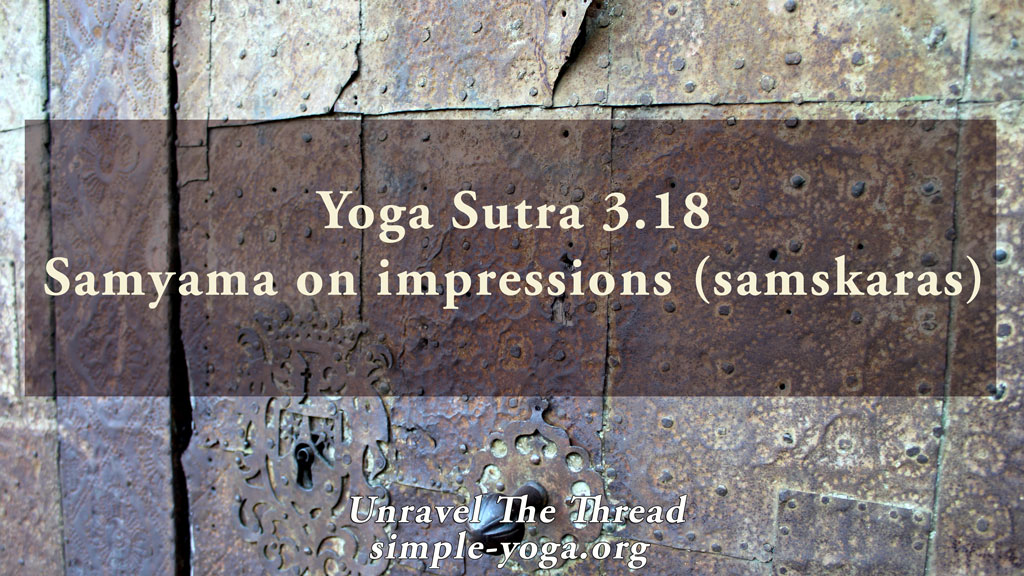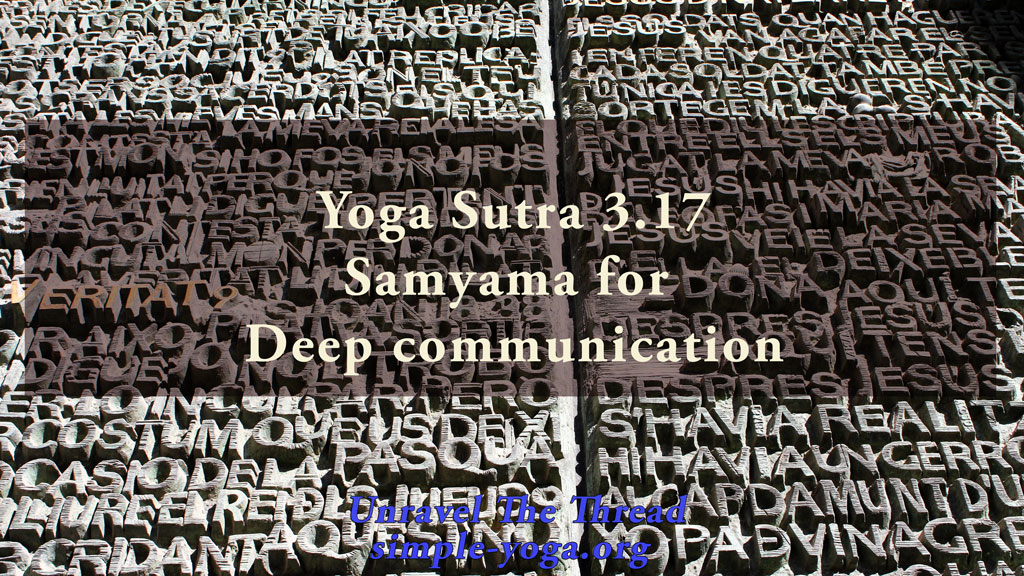
3.16 Knowing past and future
September 1, 2021
3.18 Samyama on impressions (samskaras)
September 12, 20213.17 Samyama for Deep communication

3.17 Meditative integration (samyama) on the difference between word, object and concept offers insight into the language of all beings, enabling deep communication with all beings.
This sutra presents the effects of practicing samyama on communication and it can be related to the thread started with sutra 1.42 (savitarka samadhi). As humans, we use words to refer to objects in the world. The word is not the actual object. The word apple is not something that has a color, texture, fragrance, and taste that can be eaten. The word is a sign pointing to a class of objects agreed upon. As you are reading the word apple, you may immediately think of a specific type of apple, maybe it is a gala, fuji, pink lady or granny smith. Each one of these types of apples has some overlapping properties with the others, while at the same time each one has its own unique characteristics. The word apple triggers a recall for the concept in your mind associated with it. That concept is different from the actual object and from the word. The concept is likely influenced by your own personal history. So, if you grew up eating apple pie baked at home, it is likely that the concept of apple may be related to the smell of apple pie baking and of the person who used to make it. A person who grew up in a subtropical region where apples did not grow may think of different images or memories when seeing or hearing the word apple. The concepts each person carries are influenced by that person’s life experiences and personal history. Those concepts may become an obstacle to apprehending something fully, especially when what is perceived goes against what is assumed or expected. In those cases, perception tends to be biased by unchecked assumptions.
At the simplest level, this sutra can be interpreted as meaning that samyama, because it happens once internal chatter has been removed, provides greater clarity of mind, enabling you to communicate deeply and genuinely without misunderstandings resulting from biases and assumptions. Then, when you are listening to any message, you are truly listening and not trying to respond or defend an opinion or belief. This is the simplest level of meaning in this sutra, yet arguably it is extraordinary to find a person who is capable of listening without confusing word, object, and concept and thus able to understand with an open mind and an open heart. Is this an avenue you’d like to explore?
This sutra may also mean that samyama can make it possible for the practitioner to understand all languages and all forms of communication. If you have a pet, can you notice the different ways they use to communicate with you? Might it be possible that communication with all beings can be deepened?
Is it possible that all humans know a language that is deep at the core of our beings – a language that is expressed through laughter, gratitude, love and compassion?
As usual, one more way of exploring the meaning of this sutra is by chanting it.
You can choose to chant it in its traditional form with some of the words coming together:
3.17 śabdārthapratyayānāmitaretarādhyāsātsaṃkaraḥ tatpravibhāgasaṃyamāt sarvabhūtarutajñānam
शब्दार्थप्रत्ययानामितरेतराध्यासात्संकरः तत्प्रविभागसंयमात् सर्वभूतरुतज्ञानम् ॥१७॥
Another option is to chant each word in the sutra individually:
- śabda
- artha
- pratyayānām
- itara
- itara
- adhyāsāt
- saṃkaraḥ
- tat
- pravibhāga
- saṃyamāt
- sarva
- bhūta
- ruta
- jñānam
If you prefer, you may listen to the podcast:
Unravel the thread is now available as a book!
If you find Simple-Yoga.org and Unravel the thread useful, consider supporting my labor with a donation, you may also donate using PayPal or Venmo. Thank you!



